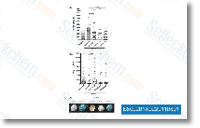Due to the fact only a single reading of your photos was carried out within this research, the intra reader and inter reader variability on the nine stage MRI cartilage score is just not regarded. That MRI is excellent at monitoring cartilage loss in RA will not be surprising. Very first, the MRI tomographic viewing point of view obviates projection in the rims of your concave articular surfaces of joints more than the joint space, which could mimic JSN on traditional radiographs.Furthermore, ligamentous laxity. rupture and interposition of synovial tissue or joint effusion involving articular surfaces can lower the accuracy of XR JSN as being a measure of cartilage reduction.So, the potential of MRI to visualize articular cartilage immediately instead of only around the basis of your width of the space involving opposing articular cortices is really a considerable advantage.The MRI protocol utilized in this review would be the Serdemetan clinical trial identical as that employed for monitoring bone erosion with RAMRIS in lots of other clinical trials of RA.
Thus, MRI protocols will not need to be expanded so that you can add MRI cartilage score to assessments of joint damage. Fat suppressed, T1 weighted, three dimensional, gradi ent echo scans are already proven to delineate articular cartilage accurately in various joints, including the MCPs.and are commercially readily available on all clinical MRI methods working at magnetic field strengths of one. 0 T or increased. Methods Temsirolimus structure working at reduce discipline strengths at this time have issues with this particular system on account of limitations in spectral excess fat suppression or selective water excitation. Selective unwanted fat suppression or water excitation is important for raising T1 contrast among cartilage and adjacent joint fluid or subchondral bone and for elimi nating chemical shift results.which distort cartilage bone interfaces and will simulate cartilage thinning and JSN.
Expanding receiver bandwidth can lower chemical shift, but this reduces the signal to noise ratio with the pictures,  and does not wholly do away with the problem. Conclusions In conclusion, the findings presented on this review, taken in combination with those from prior scientific studies validating cartilage evaluation with MRI towards JSN scoring with XR, recommend that MRI may perhaps provide a superior different to XR in multi web page clinical trials of RA. Using the latest shift in the direction of energetic comparator study models, which call for longer examine durations and more patients to demonstrate therapeutic superiority, as well as escalating problems in recruiting RA individuals into clinical trials, there’s a increasing have to have for a lot more sensitive approaches, for instance MRI, to offset the escalating expenditures, patient exposure and logistical problems linked with these trends.
and does not wholly do away with the problem. Conclusions In conclusion, the findings presented on this review, taken in combination with those from prior scientific studies validating cartilage evaluation with MRI towards JSN scoring with XR, recommend that MRI may perhaps provide a superior different to XR in multi web page clinical trials of RA. Using the latest shift in the direction of energetic comparator study models, which call for longer examine durations and more patients to demonstrate therapeutic superiority, as well as escalating problems in recruiting RA individuals into clinical trials, there’s a increasing have to have for a lot more sensitive approaches, for instance MRI, to offset the escalating expenditures, patient exposure and logistical problems linked with these trends.
Met Receptor Signal
Cancer stem cells are thought to hijack the ability of normal stem cells to express MET.
